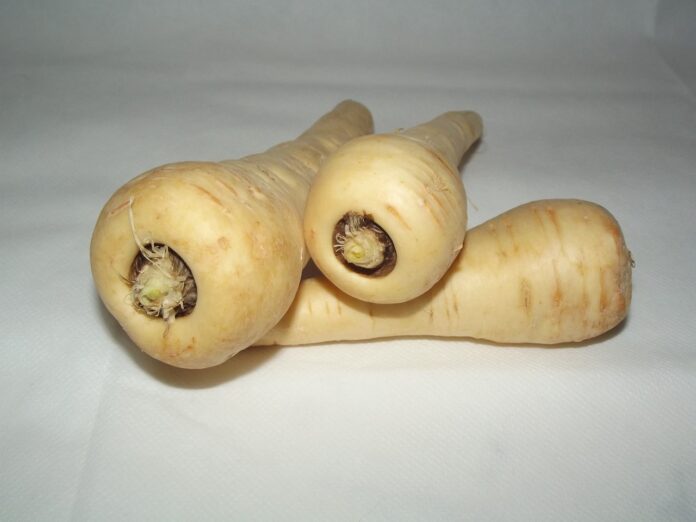Parsnips (scientific name: Pastinaca sativa) are root vegetables closely related to carrots, characterized by their white or cream-colored, tapered roots and sweet, nutty flavor. Native to Europe and Asia, parsnips have been cultivated since antiquity and were an important staple in medieval Europe before the introduction of the potato.
Interesting Facts About Parsnips:
- Historical Staple: Parsnips were a common food source in Europe for centuries before potatoes became widely available. They were used in soups, stews, and bread, and during the Renaissance, they were even used as a form of currency for trade in some cultures
- Sweetened by Frost: The natural sugars in parsnips are enhanced after exposure to frost, which makes them sweeter. This is why parsnips harvested in the fall or winter have a sweeter flavor than those harvested in warmer months
- Nutrient-Rich: Parsnips are high in dietary fiber, potassium, and vitamin C. A single cup of raw parsnips provides 6 grams of fiber, which is essential for digestive health. They are also a good source of antioxidants that can help lower the risk of chronic diseases
- Wild Varieties: While cultivated parsnips are a common sight, wild parsnips grow in some parts of Europe and North America. However, wild parsnips are smaller, less sweet, and often have a more bitter taste
- Distinct Appearance: Parsnips are often compared to carrots due to their similar shape, but they have a pale, ivory-colored skin and are usually larger and thicker. The flesh is creamy white, and it becomes sweeter as it matures, especially after exposure to frost
- Versatile Roots: Beyond culinary uses, parsnips have historically been fermented to make alcoholic beverages such as parsnip beer and wine. This practice was especially popular in Europe until the 19th century
- Variety Names: Some popular parsnip varieties include the ‘Hollow Crown’ parsnip, known for its classic sweet flavor, and ‘Gladiator,’ which is resistant to pests and diseases, making it a great choice for organic farming
- Sustainability: Parsnips are often grown on smaller scales compared to other vegetables, which means they are less likely to contribute to large-scale pesticide use, making them an eco-friendly choice for consumers
- Easy to Grow: Parsnips are hardy and grow well in colder climates. They thrive in the ground even through the winter, meaning they can be stored in the soil until ready for harvest without losing flavor
- Parsnip Festivals: In areas like Wicklow, Ireland, parsnips are celebrated at festivals where local growers and chefs share dishes made from the root vegetable. These festivals help highlight the versatility and importance of parsnips in regional cooking
- Fiber Boost: Parsnips are a fantastic source of dietary fiber, which is crucial for digestive health. Eating just one cup of raw parsnips provides 6 grams of fiber, which helps regulate blood sugar and supports gut health
- Low-Calorie Choice: Parsnips are low in calories, offering a nutritious option for those watching their weight. One cup of raw parsnips contains only about 100 calories, making them an excellent addition to balanced diets
- Alternative Flour: Ground parsnips can be used as a gluten-free flour alternative, perfect for people with gluten sensitivities or those following a gluten-free diet
- Parsnip Chips: When sliced thinly and baked or fried, parsnips make a crunchy, healthier alternative to traditional potato chips. Their natural sweetness adds a unique flavor to homemade chips
- Cultural References: Parsnips have made appearances in literature, such as in Shakespeare’s play “The Merry Wives of Windsor,” where they were used in a humorous reference to a food that could cause gas
- Magic in Folklore: In certain European folklore, parsnips were considered to possess magical powers, often used in spells or rituals, particularly related to fertility and protection
- Sweeten Your Bake: The natural sweetness of parsnips makes them an excellent choice for baking. They can be used to make cakes, muffins, or sweet bread, providing moisture and a mild, earthy sweetness
- Low Glycemic Index: Compared to other root vegetables, parsnips have a low glycemic index, meaning they have less of an impact on blood sugar levels. This makes them a good choice for people with diabetes or those trying to manage their blood sugar
- Parsnip Noodles: Spiralized parsnips can serve as a low-carb, gluten-free alternative to traditional pasta. They make a nutritious base for a variety of sauces and dishes
- Frost-Friendly Storage: Parsnips have a natural frost tolerance, allowing them to be left in the ground throughout the winter and harvested when needed. This is a convenient method for gardeners with limited storage space
- Edible Greens: While not commonly consumed, the greens of the parsnip plant are technically edible. However, they contain compounds that can cause skin irritation in some people, so it’s important to handle them with care
- Native to Eurasia: Parsnips are native to regions of Europe and Asia. They were cultivated in ancient Greece and Rome, where they were used in a variety of dishes and medicinal preparations
- Festive Beverages: During medieval times, parsnips were fermented into alcoholic drinks such as parsnip wine and beer. These beverages were common during times when other sources of alcohol were scarce
- Pioneered by Colonists: Early American settlers brought parsnips to North America, where they were successfully cultivated in the cooler northern regions. The vegetable became a staple in colonial diets
- Long Storage Life: Parsnips can be stored for several weeks when kept in a cool, dry place. This makes them an ideal vegetable for storing through the winter months, allowing for fresh root vegetables even during colder seasons
- Root for the Winter: Because they thrive in colder climates and are frost-tolerant, parsnips are one of the few vegetables that can be harvested in the winter, providing a fresh vegetable source during months when other produce is scarce
